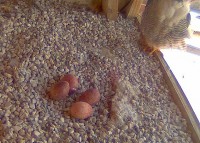Lawrence peregrines: 4 eggs!
April 10, 2017 in In the Nest Box
 The female Peregrine in Lawrence has finally laid all four eggs, a bit later than usual for this location. Here’s how the process works. Once fertilization occurs the egg begins moving down her oviduct. It’s sort of on an assembly line where the egg gets built, layer by layer. First comes several coatings of yolk. The egg moves a little farther down the ovidicut where it gets covered with albumen (the clear fluid that we’d call egg white) and various membranes. Then it continues on its way until shortly before she’s ready to lay the egg, it gets its final layer, the shell. The whole process takes a little more than a day.
The female Peregrine in Lawrence has finally laid all four eggs, a bit later than usual for this location. Here’s how the process works. Once fertilization occurs the egg begins moving down her oviduct. It’s sort of on an assembly line where the egg gets built, layer by layer. First comes several coatings of yolk. The egg moves a little farther down the ovidicut where it gets covered with albumen (the clear fluid that we’d call egg white) and various membranes. Then it continues on its way until shortly before she’s ready to lay the egg, it gets its final layer, the shell. The whole process takes a little more than a day.
The actual act of laying the eggs can take as little as a few minutes or as long as an hour or more. When she’s ready to lay her egg, the female will sit in the scrape. She may look like she’s sleeping, or at least taking a nap, but if you watch carefully, you’ll notice that she starts to move around as the egg is laid. She typically keeps the egg covered after it’s laid for 10 to 20 minutes before moving off the nest and letting us have a good look.
Peregrine eggs are speckled, and vary in color from light pink to darker brown or purple. Older falcons may produce lighter colored eggs. Each one is about the size of a small chicken egg.
One bit of behavior that many people find unusual is that she won’t begin incubating the eggs, or brooding, right away. Believe it or not, that’s perfectly normal for Peregrines. She’ll begin brooding when the next to last egg is laid, so when she starts, we can be pretty sure we know how many eggs she’ll lay– just add one to the current number. Before then, she’ll mostly leave the eggs uncovered. Don’t worry though– Peregrine eggs can survive just fine unless the temperature drops below freezing. If that happens, she’ll sit on the eggs just to keep them warm enough to stay viable. We’ll talk more about brooding and incubation soon. In the meantime, keep watching!
In this photo on Monday morning after the last eggs were laid over the weekend, the female is taking a break and resting on the outer edge of the nest box!
